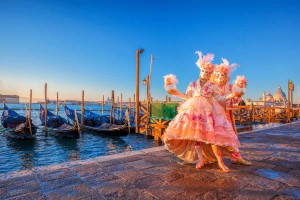
©Bigstock.com/extravagantini
Snow, ice, freezing cold – there’s nothing you long for more than getting away from the daily grind, at least for a little while. We recommend taking a trip to Venice, the city of lagoons, where you immerse yourself in a truly extraordinary event and become part of the whole ado. The Carnival of Venice is among the most beautiful and fascinating festivities in all of Italy. Hidden behind elaborate mask, you celebrate carnival season with its many parties and parades. This year’s Carnival of Venice from 27 January to 13 February 2018 once again promises a plethora of awesome highlights. Read on to find out what awaits you and how the carnival actually became the carnival.
Boom, decline and revival
It has become impossible to retrace the exact origins of the Venetian carnival. First documented mentions of carnival festivities can be found in the chronicle of the Doge Vitale Falier mentioning the year 1094, while masks apparently became part of guild parades during the 13th century. Other sources connect the carnival with a feast on the Thursday before Ash Wednesday honouring Vitale II Michiel, who defeated Ulrich II of Treven, the Patriarch of Aquileia, in 1162. Fireworks, dance performances and human pyramids were part of the celebrations also heralding the start of carnival season.
Over the course of the next decades and centuries, morals loosened up making the carnival even grander. The baroque carnival tried to maintain Venice’s prestige during a time when the city lost its role as a main global market place. While it is unknown who exactly was responsible for the restrictions and bans in the years 1797 and 1815, the festivities came to a complete halt with only very few notable exceptions, until Federico Fellini’s movie Casanova lead to an eventual revival in 1979. Nowadays, the Carnival of Venice is one of the most glorious festivities in all of Europe attracting tourists from all over the world.
The carnival now and then
Today’s carnival ado has only little to do with the origins of the festivities. Wild celebrations were originally a thing of common people, whose performances and wild dances, accompanied by colourful fireworks, turned night into day. Puppetry on Piazza San Marco was one of the most popular of the countless performances. It transported traditional mask into adventurous settings, frequently accompanied by exotic animals. Acrobats and funambulists, astrologists and charlatans were also part of the proceedings. The acrobatic Flight of the Angel first took place in 1548 and now marks the official start of the carnival.
Only very little is left of such wild jugglery and artistry. The modern Carnival of Venice officially opens ten days before Ash Wednesday through the aforementioned Flight of the Angel. It sees an acrobat scaling the Campanile on Piazza San Marco, throwing roses into the crowd and subsequently balancing down to the grandstand in front of the Doge’s Palace. The actual festivities, however, usually kick off one week early. Various artistic performances line Piazza San Marco, which itself is frequented by people wearing extraordinary masks and costumes. Among the highlights are the beauty contest Festa delle Marie and the annual awards for the most beautiful costume and the best mask.
Legendary masks and costumes
The exact origins of the famous Venetian masks remain a mystery. Researchers believe that covering up the face might have been the general public’s answer to the rigid class hierarchy of the erstwhile Republic of Venice. An 18th century document sheds further light on carnival costumes listing several masks, some of which are still being worn. Among the best-known are the Colombia, which covers eyes, nose and upper cheeks, and the full-face-covering Bauta. Worn with a hooded cape, it provides full anonymity and can also be seen on select days outside carnival action. The masks continued to be an integral part of the growlingly extraordinary and outlandish costumes even after the carnival’s revival in the 1970s. Well-known designers refine traditional outfits with modern elements and noble embellishments. Classic or inventive, the costumed spectacle on Piazza San Marco continues to fascinate the masses.
Carnival of Venice 2018
The Carnival of Venice 2018 takes places from 27 January to 13 February. With its countless festivities and celebrations, a full list of which you can find at www.carnevale.venezia.it, this year’s edition again promises costumed superlatives. We particularly recommend the following highlights:
- Water feast (27/28 January): The big opening ceremony takes place over two days. Travel through the city on gondolas accompanied by masked splendour and culinary delights during the water spectacle on the Rio di Cannareggio.
- Festa delle Marie (3 February): Starting at 2.30 pm, this massive parade leads from Via Garibaldi to Gran Teatro di San Marco on Piazza San Marco, where the city’s twelve most beautiful women are elected.
- Flight of the Angel (4 February): This traditional balancing act high above Piazza San Marco officially kicks of the Carnival of Venice.
- Beheading of the Bull (8 February): A vast parade on Piazza San Marco celebrates the “Beheading of the Bull” – a re-interpretation of Vitale II Michiel’s victory over Patriarch Ulrich II of Treven.
- Flight of the Lion (13 February): Shrove Tuesday sees the end of the lively celebrations, during which the winged lion of Saint Marcus is received by the twelve beautiful women before flying back onto the Campanile.
If you have a bit more time at hand, you might want to check out the numerous fascinating sights of the city. Reach the genuine highlights and hidden treasures of Venice in no time with the ZAINOO city tours. Don’t forget to bring your mask!